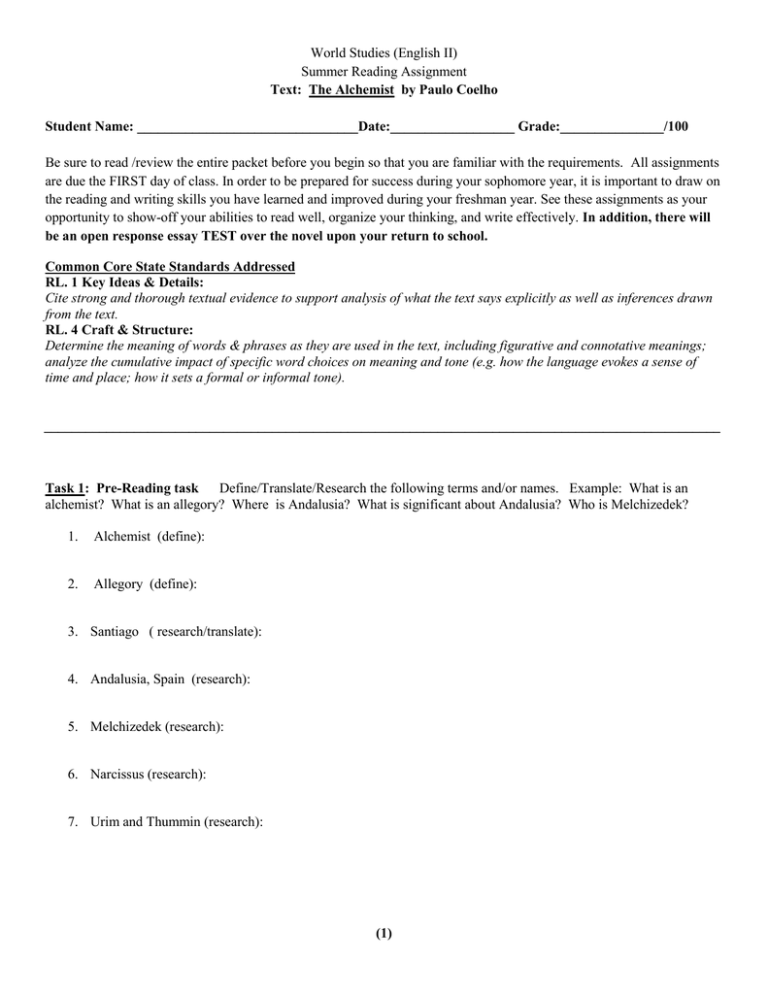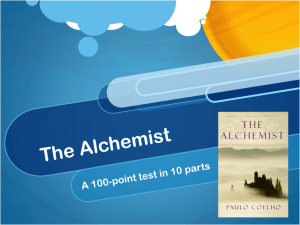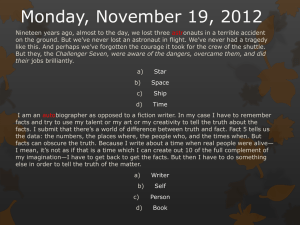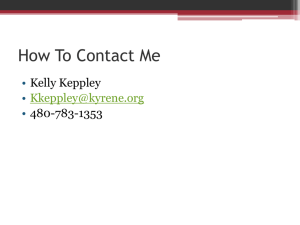Best-World-Studies-Summer-Assignment-2015-16
advertisement

World Studies (English II) Summer Reading Assignment Text: The Alchemist by Paulo Coelho Student Name: ________________________________Date:__________________ Grade:_______________/100 Be sure to read /review the entire packet before you begin so that you are familiar with the requirements. All assignments are due the FIRST day of class. In order to be prepared for success during your sophomore year, it is important to draw on the reading and writing skills you have learned and improved during your freshman year. See these assignments as your opportunity to show-off your abilities to read well, organize your thinking, and write effectively. In addition, there will be an open response essay TEST over the novel upon your return to school. Common Core State Standards Addressed RL. 1 Key Ideas & Details: Cite strong and thorough textual evidence to support analysis of what the text says explicitly as well as inferences drawn from the text. RL. 4 Craft & Structure: Determine the meaning of words & phrases as they are used in the text, including figurative and connotative meanings; analyze the cumulative impact of specific word choices on meaning and tone (e.g. how the language evokes a sense of time and place; how it sets a formal or informal tone). __________________________________________________________________________________________________ Task 1: Pre-Reading task Define/Translate/Research the following terms and/or names. Example: What is an alchemist? What is an allegory? Where is Andalusia? What is significant about Andalusia? Who is Melchizedek? 1. Alchemist (define): 2. Allegory (define): 3. Santiago ( research/translate): 4. Andalusia, Spain (research): 5. Melchizedek (research): 6. Narcissus (research): 7. Urim and Thummin (research): (1) Task 2: Cause Effect Flow Chart and Paragraph Causes and the effects are common to most literature. Often an event will occur or have several “causes” with one or more “effects”. For instance, in Romeo and Juliet, Juliet’s death – the effect- was caused by a series of events among characters (the Friar, the Feud, etc…). Please trace a cause effect relationship that occurs in the text. MUST BE HANDWRITTEN in the chart provided 1. Decide on an effect/ outcome or consequence 2. Trace it back to at least 3 separate causes and explain with text support and page number how your “causes” contributed to the effect. Causes 3. Juliet’s cousin, Tybalt is Killed by Romeo Page # Explanation (Document quote and Pg #s) Act III, Pg 322 –“Romeo is banished” and cannot reach Juliet. 2. 3. 1. 2. 3. 1. 2. 3. (2) Effect/Outcome/Consequence (list one) Juliet’s Death Task 3 Authors use many tools and approaches in their writing. As a reader of the text, locate relevant textual quotes that show the changes Santiago goes through. Track these changes chronologically by listing the page number, actual quote, a summary, and offer an explanation as to how the example characterizes Santiago. MUST BE HAND-WRITTEN on chart provided NOTE: Ten examples should be chronological and spread evenly throughout the book. Task 3 Chart Track Santiago’s development as a character Page Passage word-for-word # (1) 22 (2) (3) (4) (5) (6) Merchant- “…whoever you are, or whatever it is that you do, when you really want something, it’s because that desire originated in the SOUL of the universe.” Summary The merchant discusses the idea that the universe has an actual SOUL, which would infer that it is alive and capable of feelings and thought. Explanation of how it affects characterization Santiago is introduced to this idea that the universe is a living thing with a soul through this use of Personification. This allows Santiago to believe in his journey because this “force” will work with him to realize his own Personal Legend. (7) (8) (9) (10) (4) Task 4 Create Flash Cards – these will be used all year. (Use a ring to fasten all the cards together) The following literary devices will be used throughout the year. Students will be tested on the definitions and applications upon returning to school in August. 1. Simile – a figure of speech in which two unlike things are explicitly compared 2. Metaphor – a figure of speech in which a term or phrase is applied to something to which it is not literally applicable in order to suggest a resemblance, as in “A mighty fortress is our God.” 3. Juxtaposition – an act or instance of placing close together or side by side, especially for comparison or contrast. 4. Theme – a unifying or dominant idea (a phrase… more than 1 word) 5. Syntax – the arrangement of words/patterns in a sentence 6. Diction – style of words the author uses 7. Denotation – dictionary definition 8. Connotation – emotional implication a word carries 9. Tone – author’s attitude 10. Mood – distinctive emotional quality or feeling 11. Hyperbole – obvious and intentional exaggeration “it’s raining cats & dogs.” 12. Understatement – the act or an instance of understating, or representing in a weak or restrained way that is not borne out by the facts: The journalist wrote that the earthquake had caused some damage. This turned out to be a massive understatement of the devastation. 13. Allusion –A reference to a well-known literary work, artwork, historical person, or event 14. Paradox – a statement or proposition that seems self-contradictory or absurd but in reality expresses a possible truth. 15. Symbol – something used for or regarded as representing something else 16. Personification – the attribution of human nature or character to animals, inanimate objects, or abstract notions, especially as a rhetorical figure 17. Archetype – the original pattern or model from which all things of the same kind are copied or on which they are based (A hero or a villain) 18. Irony a. Dramatic – situation of a drama and is understood by the audience but not by the characters in the play. b. Situational – a situation in which actions have an effect that is opposite from what was intended (firehouse burns down) c. Verbal – Sarcasm 19. Imagery – the formation of mental images, figures, or likenesses of things, or of such images collectively Visual (Sight) Auditory (Sound) Olfactory (Smell) Tactile (Touch) Gustatory (Taste) 20. Antithesis – opposition, or contrast of ideas or words in balanced parallel construction. (Ex. Ask not what your country can do for you, but what you can do for your country – J.F.K.) (5) Task 5 Authors use many tools and approaches in their writing. Some tools or approaches an author might use are specific vocabulary and imagery. As a reader of the text, discuss 10 tools or approaches (you are encouraged to use examples from the list you studied in task 4) the author used, provide the passage and page number, and explain why you think the author used this tool. MUST BE HAND-WRITTEN on chart provided List: (NOTE: You may repeat up to 5 examples of a device.) 1. Identify a passage that includes a literary device (personification, hyperbole, foreshadowing, symbolism or situational irony), summarize the passage in the summary column, and then explain why the author used it. Task 5 Chart Tool / Page Approach # EX: Symbolism 1. 2. 3. 4. 29 Passage word-for-word Summary “Before the boy could reply, a butterfly appeared and fluttered between him and the old man. He remembered something his grandfather had once told him: that butterflies were a good omen. Butterflies can fly and symbolize freedom. Santiago sees a butterfly while talking and is reminded of their sign of goodness to come. Explanation of why author used it Butterflies have wings and can fly; however, they are also delicate and beautiful. Butterflies and their symbolism carry a positive connotation and foreshadow good things to come for Santiago. 5. 6. 7. 8. 9. 10. Summary: (50 at 2 pts each) 1. Task #1 – Definitions/Research (7) 2. Cause/Effect (3) 3. Character Development Passages (10) 4. Flash Cards – Literary Devices (20) 5. Literary Device Evidence Chart (10)……………………… (7) Total _________/100



